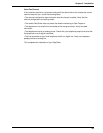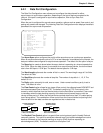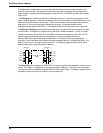
68
DataTalker Owner’s Manual
The Echo option enables data entered on the channel device keyboard to be returned to the
channel device monitor. The purpose of this option is so that an operator will not experience
undue delays in seeing entered data appear on their monitor. The default condition for the echo
option is off.
The Pacing option controls the data flow to the channel device. This option only applies to the
async mode of operation. Pacing is necessary when the flow of data to a device operating on the
data channel is more than it can process. If the channel device cannot process the volume of
data sent to it, then the pacing option should be turned on. The pacing method used is
determined by the type of flow control. The default condition is for this option to be turned off.
The EIA Pass Through option allows the channel device to receive EIA control signals through
the DataTalker. This option only applies during the async mode of operation. Since, in normal
interactive operation, the existence of a DataTalker should be transparent to the user, the EIA
pass through option allows a terminal to operate as if it were connected directly to a
communications line and not through a DataTalker. This is done by allowing selected pins
(signals) on one DataTalker to be passed through to selected pins on a remote DataTalker. The
default condition is for this option to be turned off. The following diagram shows how the EIA
pass through option routes the selected signals:
Composite Link
Facility
IN 4
IN 20
IN 25
OUT 8
OUT 6
UT 22
8 OUT
6 OUT
22 OUT
4 IN
20 IN
25 IN
DataTalker
A
DataTalker
B
The Pass Xon option enables the XON/XOFF flow control signals to be passed on to the channel
device. This option only applies during the async mode of operation. This option has to be used
in conjunction with the software-based XON/XOFF flow control option. The default condition is for
this option to be turned off, and normally it should remain off.


















